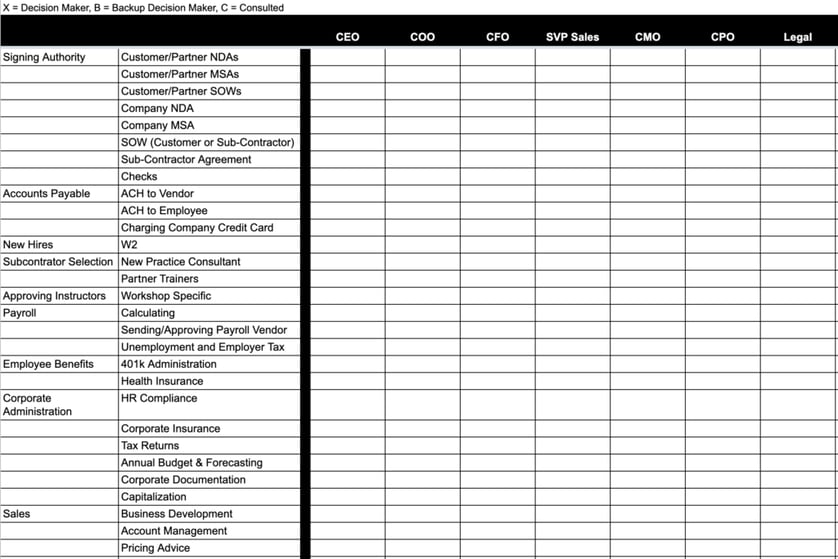Rather than limp along with a broken process, we stopped, stepped back, and developed a Decision Rights Framework. This not only led to faster decisions, but better outcomes — because we had the right people making the right decisions.
Where Decisions Right Mean Life or Death
To create the Decision Rights Framework (DRF), we leveraged a handful of principles from my Marine Corps experience:
- Unity of command dictates that life-threatening, legal or financial decisions fall on the shoulders of the Commanding Officer.
- Decentralization of as many decisions as possible increases speed of execution.
- Decentralization requires clarity of boundaries for delegated decisions.
- When time permits, engage other people for alternative perspectives before committing to a decision.
We started to built our DRF by identifying the critical decisions that could expose the company to legal or financial risk and assigned those decision rights to members of the leadership team. We then listed all other decisions and identified the people in the organization with the most situational awareness and experience to make those decisions. They were granted those decision rights.
Next, we clearly identified boundaries for various decisions, such as spending limits.
Finally, we revisited the entire list to note who could be tapped for pre-decision insight and advice. For example, while leaders may want to quickly hire qualified candidates to fill open positions, we also knew that better hiring decisions originate from multiple interviews and observations.

A sample Decision Rights Framework
Building Decision Rights Matrix
The DRF starts as a matrix. Decisions are placed in rows by category. The roles in the organization are placed in the columns. (See the sample above.) The decision makers, backup decision makers, and those to be consulted are then assigned. As we learned from our own experience, the process of identifying decision makers is iterative and generative. After we created the first version of our matrix, we identified additional decisions and categories that we missed.
While this exercise may seem daunting, our leadership team identified a total of only 43 decisions to drive our entire business.
Prior to implementation, we shared our framework with the entire company and people provided useful input to make adjustments. We then tested it for a few months. With the exception of a few edits, our framework was successful and has served its purpose of accelerating decisions throughout the organization. Our onboarding process now includes introducing the framework to new employees to help them understand how we work and what decisions they can make.
A framework for our clients may contain similar business decisions and might also include more specific product and technical decisions. For example, the decisions might include and clearly identify who:
- Decides the order of the product backlog
- May contact customers for insights and research
- Selects the color palette for visual elements of the website or application
- Evaluates tools to support software development
- Chooses the programming language
- Establishes the standards for software development
Caution: Where Decision Rights Can Go Wrong
- Avoid too many decisions that include multiple decision makers. Be clear about who is providing advice versus who is ultimately responsible for the decision. Limit true consensus decisions to about 10% of the decisions.
- Don’t hide the DRF. Provide as much visibility as possible through your knowledge management system and include it in your onboarding process.
- Keep it current. Review and update the DRF at least twice a year, and announce any changes.
- Identify opportunities to consolidate and clarify. If you have more than 100 decisions in your framework, remove any duplicates and consolidate decisions. We realized opportunities to merge similar decisions and make them more clear.
- Separate processes from decision making. For example, we don’t include who approves expense reports in our DRF. We have a simple process that illustrates the expense reimbursement flow for that. Our DRF, though, is used to grant decision making rights to employees with clear limits.
Download the Decision Rights Framework Template
To help you get started, download our DRF template here:




